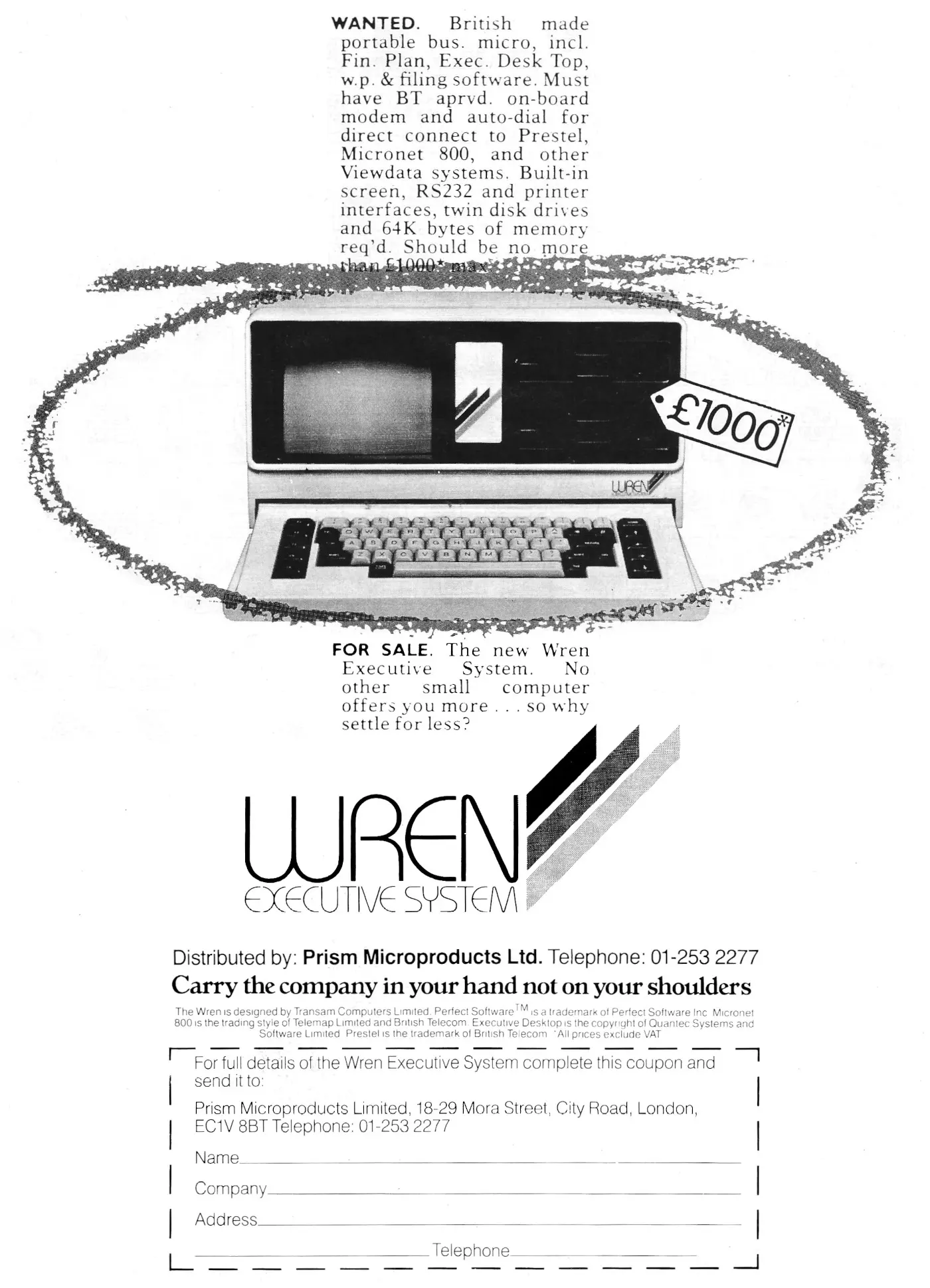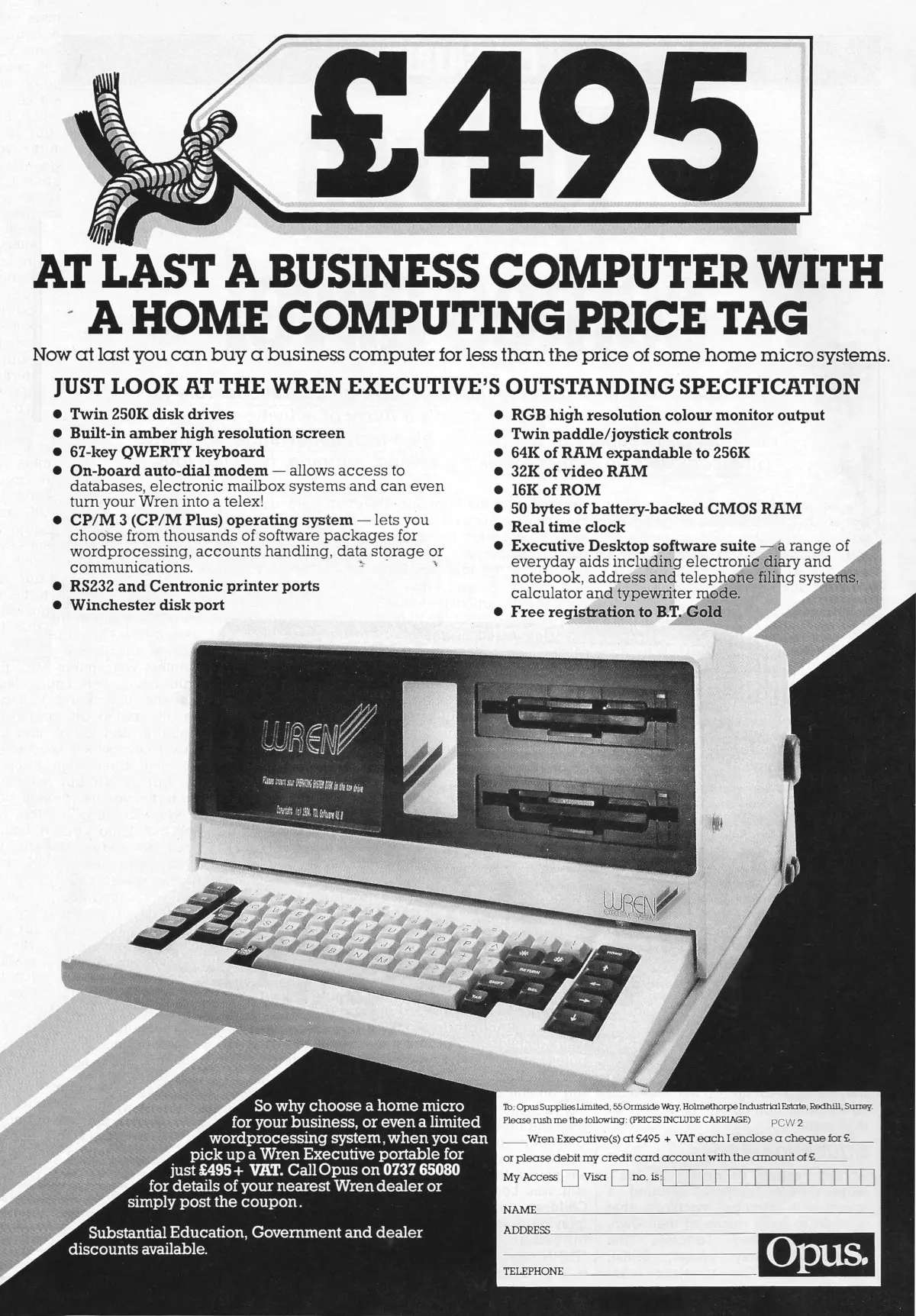Wren Computers Advert - December 1984
From Personal Computer World

The Wren Executive: Carry the company in your hand, not on your shoulders
Billed as a portable, but really just a luggable along the lines of the much earlier IMSAI PCS-80/30 from 1978 or the more contemporary KayPro, the Wren was built by Thorn/EMI, a company which was also big in the software game at the time.
It was made under contract from Wren Computers Ltd, a joint venture between Transam Microsystems - makers of the Triton and the Tuscan - and Prism, best known for its modems but which also distributed computers for, amongst others, Sinclair. It was Prism's chairman Richard Hease who was said to be the inspiration behind the new micro.
It was launched in the summer of 1984, but units were clearly in short supply as the Wren sent to Practical Computing for its June 1984 review wasn't even an early production model, but was instead what appeared to be an actual prototype with:
"a front panel attached with sticky tape and a three-bar logo cut out from coloured glossy paper and pasted on by hand. It was little more than a mock-up that happened to work"
Production of the finished product had actually been delayed, according to the rumours, by a miscalculation over the size of the casing, which turned out to be a few millimetres too small for the chassis of the computer's innards[1]
The Wren was a Z80 machine with 64K RAM and came with a built-in modem with access to the big on-line systems of the day, in particular Micronet 800 and Prestel, and which retailed for £1,150 - about £4,850 in 2025 money. Personal Computer World said of it that:
"under normal circumstances, a portable computer with all the bits including a modem and bundled software for £1,000 would appear to be good value. However, in the light of Sir Clive's latest offering [the QL] it looks rather puny"[2] .
Practical Computing's Chris Bidmead, meanwhile, despaired at what seemed like yet another "Sinclair-style" marketing launch with its "glossy brochures and pizzaz up-front and the product way behind", and questioned the pricing, which was "splendid value for the customer" but which left little room for dealers to make any money on.
He was nevertheless a little more optimistic about the machine itself, saying:
"Prism, Transam and Thorn-EMI, who together are the inspiration and embodiment of the Wren, are solidly-established British computer companies but the crucial marketing side of this venture is new to them. The Wren is flying in skies that belong to other manufacturers who are hawkish and rich, and where talons count for more than talents. Putting aside the question of marketing, the Wren is an outstanding machine. I do not know of anything that can do as much as the Wren does even at twice the price[3]".
Back in July 1983, Prism Microproducts had suffered the theft of around 3,000 Spectrums from its warehouse[4].
Sadly, Prism wouldn't be able to have that many machines stolen again as the company went bust in 1985, with only 1,000 Wrens having been made. As Prism was the majority shareholder in the joint venture, Wren was also wound up.
This was especially ironic as the Wren venture was said to have been Prism's insurance policy in case it lost the Sinclair distribution contract, which it did in early 1985 - leaving it with a large amount of unsold stock.

An Opus advert for the Wren Executive - possibly built from left-over parts, and notable for the fact it's now less than half the price at £495 + VAT, or about £2,160 in 2025. From Personal Computer World, May 1986
Although only 1,000 Wrens were thought to have been made, there were unassembled parts for another 9,000 machines[5].
It's possible that Opus Supplies Limited - a company which started out as an office furniture and supplies distributor, and which would later become relatively successfull as an IBM PC-clone maker - bought these up and assembled them for sale, as it started advertising the Wren Executive again during the spring and summer of 1986.
Date created: 29 July 2014
Last updated: 01 October 2025
Hint: use left and right cursor keys to navigate between adverts.
Sources
Text and otherwise-uncredited photos © nosher.net 2025. Dollar/GBP conversions, where used, assume $1.50 to £1. "Now" prices are calculated dynamically using average RPI per year.